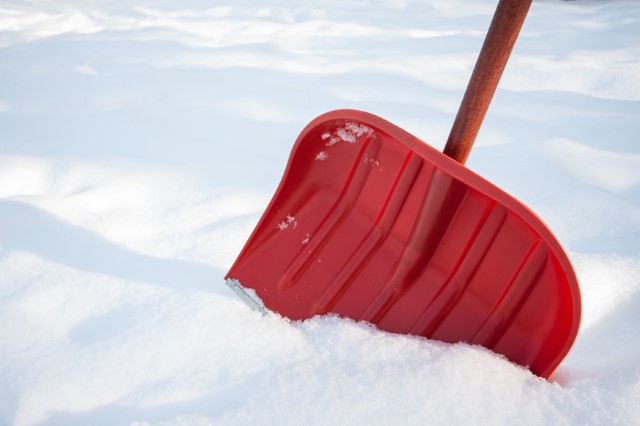 The American Heart Association/American Stroke Association says that for most people, shoveling snow may not lead to any health problems. However, the association warns that the risk of a heart attack during snow shoveling may increase for some, stating that the combination of colder temperatures and physical exertion increases the workload on the heart.
The American Heart Association/American Stroke Association says that for most people, shoveling snow may not lead to any health problems. However, the association warns that the risk of a heart attack during snow shoveling may increase for some, stating that the combination of colder temperatures and physical exertion increases the workload on the heart.
People who are outdoors in cold weather should avoid sudden exertion, like lifting a heavy shovel full of snow. Even walking through heavy, wet snow or snow drifts can strain a person’s heart.
For people with existing heart conditions like heart failure, high blood pressure or cholesterol, the increased workload on the heart from activities such as shoveling of heavy snow, can put them at higher risk for heart attack.
To help make snow removal safer, the American Heart Association has compiled a list of practical tips.
- Give yourself a break. Take frequent rest breaks during shoveling so you don’t overstress your heart. Pay attention to how your body feels during those breaks.
- Don’t eat a heavy meal prior or soon after shoveling. Eating a large meal can put an extra load on your heart.
- Use a small shovel or consider a snow thrower. The act of lifting heavy snow can raise blood pressure acutely during the lift. It is safer to lift smaller amounts more times, than to lug a few huge shovelfuls of snow. When possible, simply push the snow.
- Learn the heart attack warning signs and listen to your body, but remember this: Even if you’re not sure it’s a heart attack, have it checked out (tell a doctor about your symptoms). Minutes matter! Fast action can save lives — maybe your own. Don’t wait more than five minutes to call 9-1-1
- Don’t drink alcoholic beverages before or immediately after shoveling. Alcohol may increase a person’s sensation of warmth and may cause them to underestimate the extra strain their body is under in the cold.
- Consult a doctor. If you have a medical condition, don’t exercise on a regular basis or are middle aged or older, meet with your doctor prior to the first anticipated snowfall.
- Be aware of the dangers of hypothermia. Heart failure causes most deaths in hypothermia. To prevent hypothermia, dress in layers of warm clothing, which traps air between layers forming a protective insulation. Wear a hat because much of your body’s heat can be lost through your head.
Heart Attack Warning Signs
Some heart attacks are sudden and intense — the “movie heart attack,” where it is clear what’s happening. But, most heart attacks start slowly, with mild pain or discomfort. Often people affected aren’t sure what’s wrong and wait too long before getting help. Here are signs that can mean a heart attack is happening:
- Chest discomfort. Most heart attacks involve discomfort in the center of the chest that lasts more than a few minutes, or that goes away and comes back. It can feel like uncomfortable pressure, squeezing, fullness or pain.
- Discomfort in other areas of the upper body. Symptoms can include pain or discomfort in one or both arms, the back, neck, jaw or stomach.
- Shortness of breath with or without chest discomfort.
- Other signs may include breaking out in a cold sweat, nausea or lightheadedness
- As with men, women’s most common heart attack symptom is chest pain or discomfort. But women are somewhat more likely than men to experience some of the other common symptoms, particularly shortness of breath, nausea/vomiting, and back or jaw pain.
Calling 9-1-1 is almost always the fastest way to get lifesaving treatment. It is best to call Emergency medical services (EMS) for rapid transport to the emergency room. EMS staff can begin treatment when they arrive — up to an hour sooner than if someone gets to the hospital by car. Patients with chest pain who arrive by ambulance usually receive faster treatment at the hospital, too. If you can’t access EMS, have someone drive you to the hospital right away. If you’re the one having symptoms, don’t drive yourself, unless you have absolutely no other option.
Heart attacks can cause sudden cardiac arrest, where the heart stops beating, or beats irregularly, failing to pump enough blood. One moment, a person can be walking and talking, and the next moment they collapse, lifeless. They will be unresponsive, not breathing or only gasping. Their lips will start to turn blue and skin will become pale. Quick recognition and fast action is the key to saving a life.
WHAT YOU CAN DO
Bystanders can help cardiac arrest victims survive, if they act fast. First, call 9-1-1 and start CPR right away. Then, if an Automated External Defibrillator (AED) is available, use it as soon as possible. If two people are available to help, one should begin CPR immediately while the other calls 9-1-1 and finds an AED.
Hands Only CPR is effective in saving lives during cardiac arrest. Hands-Only CPR has just two simple steps. If you see a teen or adult suddenly collapse,
(1) Call 9-1-1; and
(2) Push hard and fast in the center of the chest to the beat of the disco song “Stayin’ Alive” (100 beats per minute) until help arrives.
To learn more about CPR or find a local class, visit www.heart.org/CPR.
